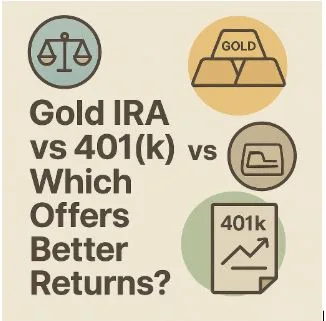Gold IRA vs 401k Which Offers Better Returns?
IRA Vs 401k Summary: When comparing Gold IRA vs 401k investment options, both offer unique advantages for retirement savings. Gold IRAs provide protection against inflation and market volatility through precious metals ownership, while 401(k)s offer employer matching and diverse investment choices. This comprehensive analysis examines return potential, risk factors, tax benefits, and long-term growth prospects to help you determine which retirement strategy best fits your financial goals.
Understanding Gold IRA vs 401k Investment Options
Choosing between precious metals IRAs and traditional workplace retirement plans requires careful consideration of multiple factors. Both investment vehicles serve the primary goal of building wealth for retirement, yet they operate through completely different mechanisms.
A Gold IRA allows investors to hold physical precious metals like gold, silver, platinum, and palladium within a tax-advantaged retirement account. These accounts follow the same contribution limits and tax rules as traditional IRAs but store actual metals instead of paper assets.
Traditional 401(k) plans, offered by employers, typically invest in mutual funds, stocks, bonds, and other securities. These plans often include employer matching contributions, which can significantly boost your retirement savings.
Historical Return Performance Analysis
Gold IRA Performance Trends
Gold has demonstrated remarkable staying power throughout economic uncertainty. Over the past 23 years, gold prices have increased from approximately $300 per ounce to over $3,400 per ounce, representing substantial growth potential.
During the 2008 financial crisis, gold prices rose while stock markets crashed. From 2008 to 2012, gold gained nearly 70% while the S&P 500 struggled to recover losses. This performance highlights gold’s role as a safe haven during turbulent times.
However, gold doesn’t always outperform other assets. Between 2012 and 2015, gold prices declined while stock markets soared. This volatility demonstrates why diversification remains crucial for long-term success.
401(k) Performance History
Stock market investments through 401(k) plans have historically provided higher average returns than gold over extended periods. The S&P 500 has averaged approximately 10% annual returns over the past century, though individual years vary significantly.
During bull markets, 401(k) accounts can experience explosive growth. The decade following 2009 saw many retirement accounts double or triple in value as markets recovered and surged higher.
However, 401(k) accounts also face significant downside risk during market crashes. The 2000 dot-com bubble and 2008 financial crisis wiped out trillions in retirement savings, forcing many Americans to delay retirement.
Risk and Volatility Comparison
| Factor | Gold IRA | 401(k) |
| Market Volatility | Moderate | High |
| Inflation Protection | Excellent | Poor |
| Liquidity | Limited | High |
| Growth Potential | Moderate | High |
| Downside Protection | Strong | Weak |
Gold IRA Risk Profile
Precious metals provide excellent protection against currency devaluation and inflation. When paper money loses purchasing power, gold typically maintains or increases its value. This makes Gold IRAs particularly attractive during periods of high inflation or economic uncertainty.
Storage and insurance costs can reduce overall returns in Gold IRAs. Custodial fees, storage expenses, and insurance premiums typically range from 1-3% annually, which impacts net performance.
Physical gold doesn’t produce dividends or interest, relying solely on price appreciation for returns. This limits income generation compared to dividend-paying stocks or interest-bearing bonds.
401(k) Risk Considerations
Stock market investments carry significant volatility risk. Market corrections of 20% or more occur regularly, and bear markets can last several years. Recent retirees face sequence-of-returns risk, where early losses can permanently damage retirement security.
Employer stock concentration presents another risk factor. Many 401(k) participants hold too much company stock, creating dangerous exposure to single-company failure. Diversification across asset classes helps mitigate this risk.
Required minimum distributions force retirees to sell investments regardless of market conditions. Poor timing can lock in losses during market downturns, reducing lifetime income potential.
Tax Advantages and Implications
Both investment types offer significant tax benefits, though through different mechanisms. Understanding these differences helps optimize your retirement tax strategy. Please speak to your tax advisor or gold IRA specialist to learn more.
Gold IRA Tax Benefits
Traditional Gold IRAs provide immediate tax deductions for contributions, reducing current taxable income. This benefit proves especially valuable for high earners in peak tax brackets.
Roth Gold IRAs offer tax-free growth and withdrawals in retirement. Since precious metals have appreciated significantly over time, this tax-free treatment can save substantial money for long-term investors.
Gold IRA distributions receive the same tax treatment as traditional IRA withdrawals. Ordinary income tax rates apply to distributions, which may be higher than capital gains rates for other investments.
401(k) Tax Considerations
Traditional 401(k) contributions reduce current taxable income dollar-for-dollar. Higher contribution limits ($23,000 for 2024, plus $7,500 catch-up for those over 50) provide greater immediate tax savings than IRA limits.
Roth 401(k) options allow after-tax contributions with tax-free growth and qualified withdrawals. This flexibility helps diversify your retirement tax exposure across different account types.
Employer matching contributions always go into traditional accounts, creating automatic tax diversification. These matching dollars represent free money that significantly boosts long-term returns. Speak to an IRA expert of gold custodian to learn more.
Inflation Protection and Economic Stability
How Gold Protects Against Inflation
Throughout history, gold has served as a store of value when currencies lose purchasing power. During the 1970s stagflation period, gold prices increased dramatically while stocks and bonds struggled.
Central bank money printing and government debt expansion often drive gold prices higher. As monetary supply increases, gold typically appreciates to maintain its relative value against diluted currencies.
International demand for gold provides price support independent of U.S. economic conditions. Central banks, jewelry demand, and industrial uses create consistent global demand for precious metals.
401(k) Inflation Challenges
Fixed-income investments within 401(k) plans suffer during inflationary periods. Bond values decline as interest rates rise, creating negative real returns when inflation exceeds bond yields.
Stock investments can provide some inflation protection through revenue and earnings growth. However, high inflation often leads to economic slowdowns that hurt corporate profits and stock prices.
Target-date funds automatically reduce stock exposure as retirement approaches, potentially limiting inflation protection when it’s needed most. This conservative shift may not adequately protect against purchasing power erosion.
Liquidity and Accessibility Factors
Access to retirement funds varies significantly between these investment options, affecting both emergency planning and retirement flexibility.
Gold IRA Liquidity Considerations
Physical precious metals require time and effort to sell, making emergency access challenging. Dealers must evaluate, price, and purchase metals, which can take several days or weeks.
Early withdrawal penalties apply to Gold IRA distributions before age 59½, just like traditional IRAs. The 10% penalty plus ordinary income taxes can severely reduce net proceeds from early withdrawals.
Required minimum distributions begin at age 73, forcing metals sales regardless of market conditions. Low gold prices during RMD years can permanently reduce account values.
401(k) Accessibility Features
Most 401(k) plans offer loan provisions allowing participants to borrow against account balances. These loans provide quick access to funds without penalties, though they reduce retirement savings if not repaid.
Hardship withdrawals permit access to funds for specific financial emergencies. While penalties may apply, this option provides crucial financial flexibility during crisis situations.
Job changes allow 401(k) rollovers to IRAs or new employer plans, maintaining tax-advantaged status while providing investment flexibility. This portability helps optimize long-term investment strategies.
Diversification and Portfolio Balance
Smart retirement planning incorporates both asset types for optimal risk-adjusted returns and comprehensive protection. You can sell a gold and silver IRA anytime to redistribute assets.
Creating Balanced Retirement Portfolios
Financial experts often recommend allocating 5-10% of retirement assets to precious metals for diversification benefits. This allocation provides inflation protection without sacrificing growth potential from other investments.
Geographic and currency diversification through gold ownership helps protect against U.S.-specific economic problems. International investors have used gold for centuries to preserve wealth across borders and political systems.
Age-appropriate allocation adjustments can optimize returns throughout different life stages. Younger investors might emphasize growth through 401(k) investments, while older investors increase precious metals exposure for stability.
Combining Both Investment Strategies
Using both Gold IRAs and 401(k) plans maximizes retirement savings opportunities. Employer matching in 401(k) plans provides immediate returns, while gold offers long-term protection and diversification.
Rebalancing between asset classes helps maintain target allocations and forces disciplined buying low and selling high. Regular rebalancing has historically improved risk-adjusted returns across market cycles.
Tax diversification through different account types provides flexibility in retirement income planning. Drawing from various sources helps optimize tax efficiency throughout retirement years.
Professional Guidance and Implementation
Working with Certified Gold Exchange
The Certified Gold Exchange specializes in helping clients navigate the complex process of establishing and managing Gold IRAs. Their experienced team guides investors through IRS regulations, custodian selection, and precious metals purchases.
Professional guidance ensures compliance with all IRS requirements for precious metals IRAs. Improper setup or prohibited transactions can result in account disqualification and severe tax penalties.
Ongoing account management includes storage coordination, insurance coverage, and distribution planning. These services help maximize returns while minimizing administrative burdens for busy investors.
Choosing the Right Investment Mix
Determining optimal allocation between precious metals Individual Retirement Accounts and traditional 401(k) plans depends on individual circumstances, risk tolerance, and retirement timeline. Professional advisors can help create personalized strategies that balance growth potential with downside protection.
Regular portfolio reviews ensure investment strategies remain aligned with changing life circumstances and market conditions. Adjustments may be necessary as you approach retirement or experience major life changes.
Final Thoughts
Gold IRAs and 401(k) plans each offer distinct advantages for retirement savers seeking optimal returns. While 401(k) plans provide higher historical average returns and employer matching benefits, Gold IRAs deliver crucial inflation protection and portfolio diversification. The most effective retirement strategy often combines both approaches, allowing investors to benefit from stock market growth while protecting against economic uncertainty. The Certified Gold Exchange can help clients complete all necessary documentation to establish Gold IRAs and integrate precious metals into comprehensive retirement planning strategies, ensuring your golden years remain financially secure regardless of economic conditions that may arise in the comparison between precious metals retirement accounts and traditional employer-sponsored investment plans.







